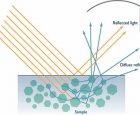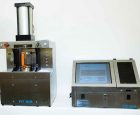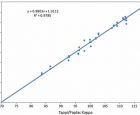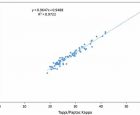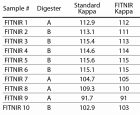
Features
Equipment & Systems
Pulp
NIR spectroscopy: a paradigm shift in pulp properties measurements
With increasing worldwide competition, pulp and paper manufacturers require greater emphasis on cost reduction and increased product efficiency and quality, while minimizing environmental impact.
November 23, 2015 By Thanh Trung Brady Conroy and Dale Wilson
Although the chemical recovery process plays a critical role in the economic viability of pulp mills, efficient operation of the digester is equally important to ensure excellent yield and product quality.
The kappa number of pulp, or residual lignin content, estimates the extent of delignification in cooking and is a critical parameter for digester and bleaching processes. To optimize cooking yield and product quality, kappa number is used as a feedback parameter to automated control algorithms allowing for adjustments to the liquor charge and time-temperature profile of the digester as well as the bleaching chemical charge in the bleach plant. Kappa measurement has become even more critical due to greater inconsistencies in chip quality (i.e., moisture content, size distribution, and species mixtures) requiring varying cooking conditions.
Traditional measurement challenges
Accurate measurements of kappa number for chemical pulp obtained from rapidly fluctuating wood quality and furnishes remains a challenge for the industry. Manual titrations for kappa (based on the KMnO4 oxidation of the lignin) require significant time and preparation steps, leading to considerable sources of error between testers and between labs. Since the analysis is most accurate when half of the KMnO4 is consumed, higher kappa numbers require smaller amounts of pulp for titration. Consequently, errors in sample weight greatly contribute to kappa testing inaccuracies.
Semi-automated and automated titration-based methods slightly reduce the time commitment in comparison to the manual methodology, but sample preparation, reaction time, and analysis steps still take a substantial amount of time (approximately 20 to 30 minutes) and use large volumes of aggressive chemicals.
Fully automated kappa analyzers are widely available, but are better suited for clean pulp that has been thoroughly washed of all residual liquor and partially bleached and bleached pulp. Because UV-visible light is strongly absorbed by lignin, the sample must be diluted to a low consistency before measurement can occur. For higher kappa numbers of linerboard pulp with kappa in the range of 80 to 110 kappa, an extremely low consistency sample is required, leading to possible errors and non-representative sampling. It has also been demonstrated that UV-visible light-based measurement techniques are dependent on species composition, thus do not lend themselves well to conditions with a varying furnish.
An innovative solution for analyzing kappa number
Jointly developed and patented by FPInnovations and FITNIR, FITNIR Kappa represents an innovative and disruptive technology for kappa number analysis. FITNIR Kappa uses diffuse reflectance Near Infrared (NIR) spectroscopy as the basis of measurement. When a continuous wave light is shone on a pulp sample, a portion of the light is reflected and the remainder penetrates and interacts with the chemical constituents of the sample before exiting. This diffusely reflected light contains the information that is absorbed by the lignin in the pulp. Optics collect the diffuse reflected light, registering its absorption on the infrared detector and generating the unique spectral features (Fig. 1). The spectral data from the analyzer is then correlated with a previously built calibration model, allowing for kappa number determination.
The spectral absorption features of lignin allow for the direct quantification of residual lignin on the pulp. Consequently, FITNIR Kappa does not rely on other parameters such as the strength of chemicals, precise sample dry weight, reaction time, or a subjective colour change With the automated sample preparation (simply washing the pulp with water and pressing into a sample puck) and sample analysis requiring only 20 seconds (Fig. 2), rapid, consistent, accurate kappa measurement is now possible.
Changing the laboratory landscape
The simplified sample preparation and analysis process of NIR spectroscopy eliminates all associated chemicals required for traditional measurement techniques, presenting the conceivable opportunity for a chemical-free lab, particularly when combined with FITNIR Benchtop liquor measurements. Consequently, chemical costs are eliminated while environmental impact and tester exposure to potentially harmful chemicals are minimized.
Based on the fundamental absorption features of lignin for calibration, calibration models can be transferred from pulp-grade to pulp-grade without requiring recalibration. Providing uninterrupted results ensures pulp kappa stays within target, even when confronted by furnish transition or poor chip quality.
Application for kraft linerboard mills
With increasing sales and transactions for all sorts of goods over the internet, the demand for kraft linerboard has seen a tremendous rise over the past decade. More linerboard producers have entered the market, leading to greater competition and optimization requirements for producers. Reliable and accurate kappa numbers are critical to produce acceptable quality pulp for packaging.
Figure 3 shows the correlation of mill samples between NIR spectroscopy (FITNIR Kappa) and autotitrator results performed as per the TAPPI/PAPTAC standard for linerboard kraft pulp. Excellent correlation was observed from 85 to 115 kappa with an R2 ~ 0.98. By simplifying and reducing the sample preparation steps which critically affect titration results, NIR spectroscopy significantly improves kappa repeatability and accuracy. Table I shows the validation outcomes comparing autotitrator results to FITNIR Kappa. Excellent correlation was again observed with an average of the difference being 0.63 kappa number and a standard deviation of the difference of 0.9 kappa.
Accurate kappa number determination for linerboard pulp represents a paradigm shift in methodology, as FITNIR Kappa can account for higher amounts of shives and some liquor carryover in the pulp. Moreover, using an approximately 80 g sample of pulp (~24 g OD) is a much better representative of kappa number.
Similarly, this technology has been applied to measure the kappa number of conventional kraft pulp for digester blowline and brownstock samples. Again, excellent correlation has been validated with mill testing (Fig. 4).
Application for final pulp sheet inspection
Pulp quality inspection at the finishing line is difficult, especially for kappa number and a series of other properties such as AD (Air Dry) content and viscosity. Often, these tests require considerable time investment to obtain accurate and reliable results. Some customers require kappa as part of the procurement criteria with which producers must provide manual testing to comply.
Manual testing cannot keep up with production and consequently analysis is performed only once every two to three hours and runs the risk of being out of compliance if swings in kappa number occur outside of the acceptable range.
To address this challenge, FITNIR Kappa determines kappa number directly on the pulp sheet. A sample is simply cut from the pulp sheet and analyzed in the spectrometer within 2 minutes. As measurements are done within minutes, mills can frequently measure kappa number for all drops, both in cross-machine and machine direction.
FITNIR Kappa is the only system of its kind that can directly measure kappa number on the pulp sheet without the use of chemicals yet can provide rapid, reliable, and accurate results. The data from FITNIR Kappa lends itself to process optimization, ensuring the target product quality is reached and maintained.
New technology brings benefits and cost savings
The progress of NIR spectroscopy technology for true kappa measurements has resulted in the development of a disruptive technology that surpasses traditional testing techniques. When combined with other spectroscopy-based technology, such as FITNIR Benchtop for liquor analysis, a chemical-free laboratory is now possible. The ability to directly measure pulp sheet kappa can lead to procurement applications and final product testing. Accurate and reliable measurements without chemical consumption translates into savings ranging from $150,000 to $250,000 per year, based on chemical costs for kappa testing. This is just the tip of the iceberg for this versatile technology. Applications are already being tested for AD content and viscosity, among many other possible parameters for improving product quality. PPC
Thanh Trung and Dale Wilson, FITNIR Analyzers Inc., Vancouver. Brady Conroy, Domtar Corp., Kamloops, B.C.
Print this page
